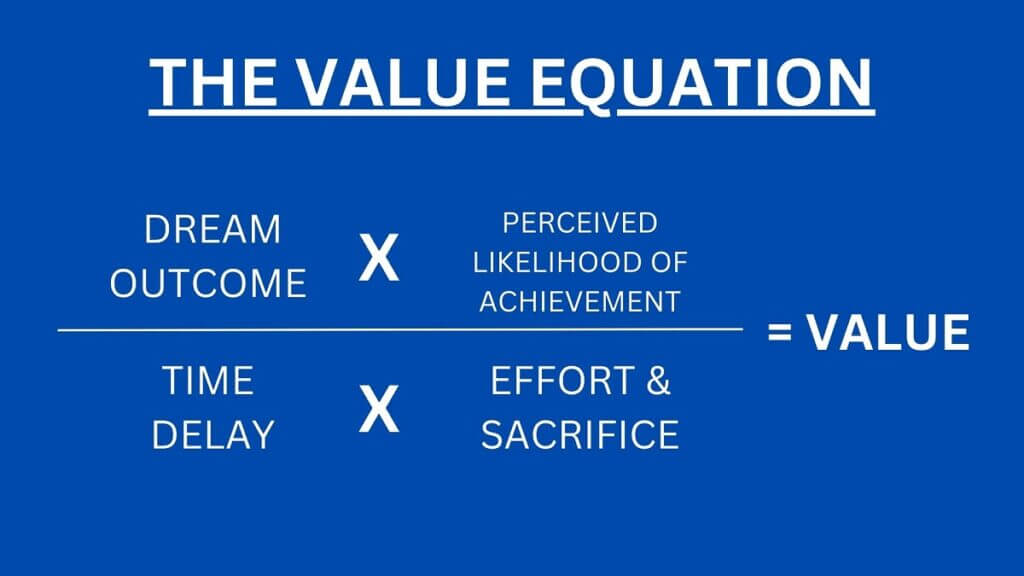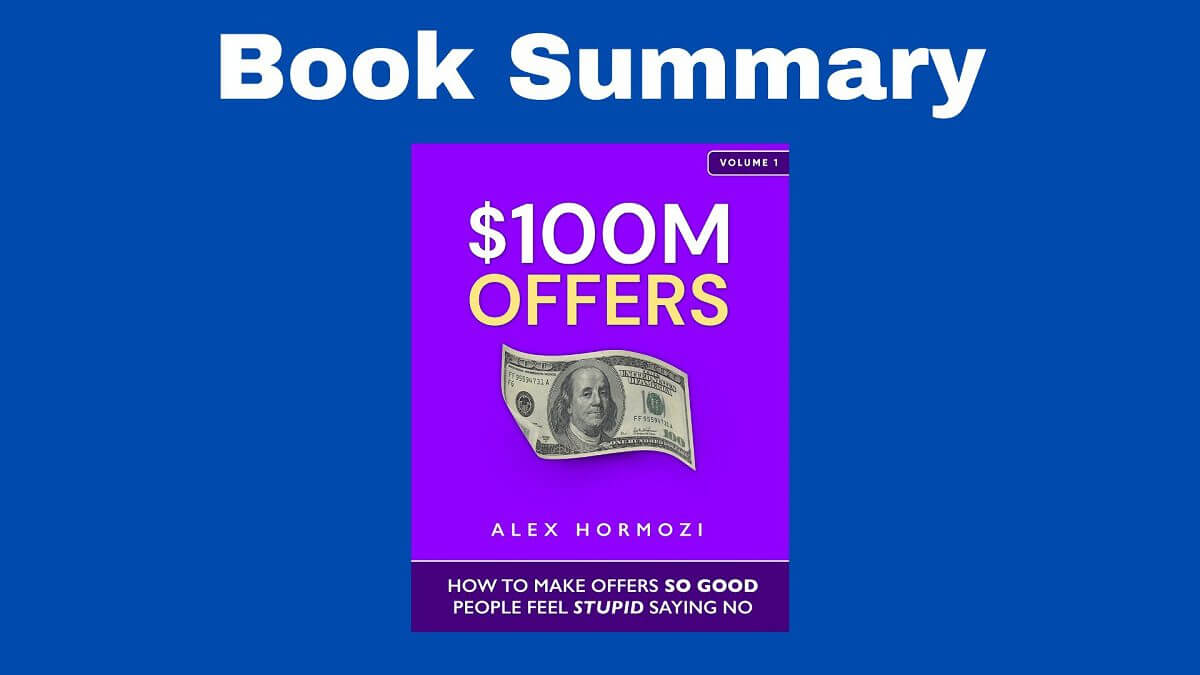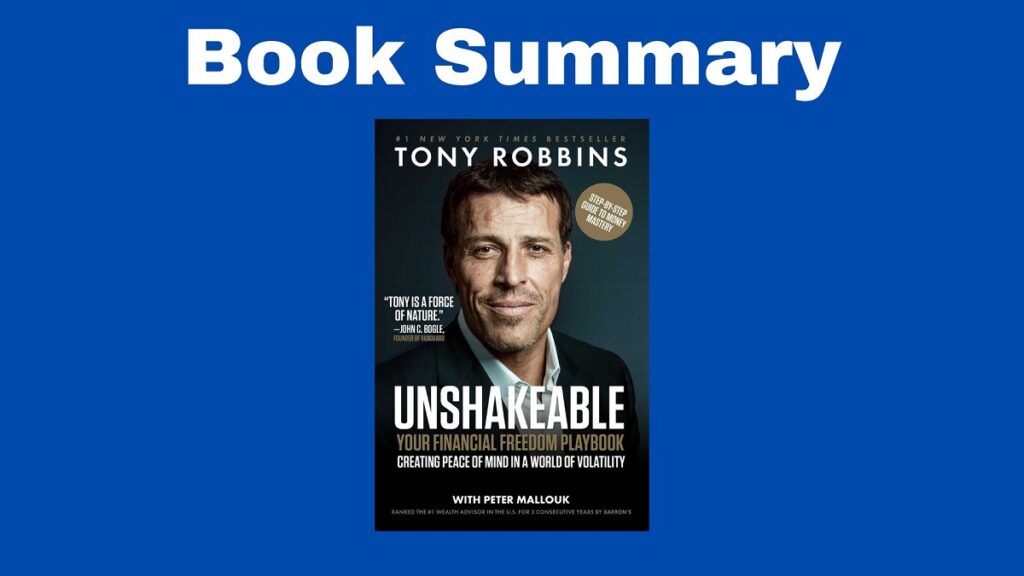The Book in Three Sentences
Alex Hormozi is the founder of $100M Offers, a business method that allowed him to create offers so good that people felt stupid saying no. This book teaches you to charge a lot of money for your services, make products that have a lot of value, and enhance your offer so that people say yes almost immediately. Additionally, this business book uses alternative marketing rules to create irresistible offers.
$100M Offers Summary
The book $100M Offers teaches you to make profitable business proposals. For the uninitiated, this is the offer that combines pricing, value, guarantees, and naming strategies is what the author calls a Grand Slam Offer. There’s no limit to the amount of money you can make through them and achieving one of those offers allows you to retire.
Section I: How We Got Here
Chapter 1: The Ugly Truth
The author went from rags to riches thanks to a Grand Slam Offer. He dedicates the rest of the book to explaining how these offer work and teaching readers how to create great offers.
Chapter 2: Grand Slam Offers
The author learned from a man running a seminar that the best way to sell something is to “make people an offer so good they would feel stupid saying no”. To sell, you don’t have to be clever or skilled, you just have to create things most people say yes to.
Entrepreneurship is about giving back to others while we get the freedom to do whatever we want. Giving back means solving problems and providing value. But while most entrepreneurs know the why behind their business, a value exchange is needed, and such trade is initiated with an offer. An offer is the goods and services you provide and the way in which customers interact with your business. So you need the best offer you can provide. This is what the author refers to as a Grand Slam Offer.
Most entrepreneurs face two main problems:
- Not enough clients
- Not enough money
Section II: Pricing
Chapter 3: Pricing: The Commodity Problem
Companies have to grow or else they die. To grow we need three things:
- More customers
- Increasing their purchase value
- Getting them to buy often
A Grand Slam Offer is the offer you provide that’s unique in the marketplace. It’s attractive and has an unrivaled value proposition, premium price, and payment terms that let you get money to get new customers. In other words, you can charge anything you want because there’s nothing like the product or service you’re offering. Your offer should be so simple and straightforward that it explains itself.
Chapter 4: Pricing, Finding the Right Market – AStarving Crowd
To be successful, there has to be demand for your product or service. Even if what you’re offering isn’t that good, you can still profit. Sometimes quitting is the right solution so that you can move onto the right market. To sell, you need demand, but don’t create it, channel it.
There are four indicators for picking markets:
- Pain: The customers desperately need your product. Their degree of pain determines the price.
- Purchasing power: The audience you target should be able to afford what you’re offering.
- Easy to target: The perfect market means nothing if you can’t find its audience.
- Growing: Growing markets move forward faster.
The three markets that will never disappear are health, wealth, and relationships. Also, niching down has the potential to make you a lot of money. By solving a problem for a unique kind of person, you’re making your product much more enticing to them and more valuable.
Chapter 5: Pricing: Charge What It’s Worth
Underneath the price you charge for your product or service, you must create and communicate value. People buy things because they think they’re getting a deal. They think they’re getting something that’s worth more than what they’re paying. As soon as the value they receive drops, they won’t pay for it anymore. This is called value discrepancy and it’s something to avoid. Warren Buffet said something along the lines of: “Price is the amount of money you get and value is what you get in return.”
Your Grand Slam Offer should be offered at a high price after increasing your value. It’s about trying to make the most money possible, so don’t charge below what everyone else is charging to remain competitive because soon you’ll be broke. To best serve your customers, charge a premium. Decreasing the price, on the other hand, negatively impacts your client’s emotional investments, perceived value, and results. You’ll also attract bad clients and destroy your margin.
By raising prices, you increase your clients’ emotional investment, perceived value, and results. You’ll attract the best clients and multiply your margins. Raising the prices enhances the value of your product as long as it delivers. Overwork your self-doubt.
Section III: Value – Create Your Offer
Chapter 6: Value Offer: The Value Equation
Although the goal is to charge as much money as you can, getting people to say yes to your offer is a completely different thing.
The Value Equation

There are four drivers of value. The two on top, you try to increase and the two on the bottom, you try to decrease.
- The Dream Outcome is what you expect to make
- The Perceived Likelihood of Achievement is what you expect to happen
- The Time Delay is how long it’ll take
- The Effort & Sacrifice is what’s expected of you
If you manage to reduce the two drivers of value on the bottom to zero, your product or service will be infinitely valuable.
How your clients (or potential clients) see your offer becomes their reality. Perception is everything and if you manage to change people’s perception of the likelihood of achievement, time delay, and effort and sacrifice and use that to your advantage, this will add value to your offer. It’s the business owner’s job to communicate value drivers as clearly as possible.
These are the value drivers explained:
- Dream Outcome: What your client wants to obtain through your product or service.
- Perceived Likelihood of achievement: The certainty with which you’ll get to a result by making a purchase.
- Time delay: This is the amount of time between a client’s purchase and getting the desired result. The shorter it is, the more valuable your product will be. People buy the long-term value, but what makes them stay are the short-term experiences and milestones along the way.
- Effort & Sacrifice: This is what it costs people to achieve a specific goal.
Chapter 7: Free Goodwill
Helping others gives you money, creates opportunities, and will make you live longer.
Chapter 8: Value Offer: The Thought Process
Convergent problem solving is when you take a series of known variables and you combine them into a single answer. Divergent problem solving is when you provide many solutions to the same problem. Some of those solutions will be right, but one of them will be more appropriate than all the others.
Chapter 9: Creating Your Grand Slam Offer Part I: Problems & Solutions
To create your offer, you first must:
- Step #1: Identify the dream outcome: Think about the destination and the experiences your clients will have along the way.
- Step #2: List problems: As you list your problems think about what happens before and after someone uses your service. Be as detailed as possible. The more problems you list, the more problems you’ll be able to solve.
- Step #3 Solutions List: Define your solutions in the form of a list. Transform problems into a solution first and make your solutions second.
Chapter 10: Value Offer: Creating Your Grand Slam Offer Part II: Trim & Stack
Above everything else, you need a valuable product. To achieve this, you need an offer that’s attractive and profitable. You must over-deliver to the point that your clients are surprised with the amount of value they’re getting for the asking price. We must find a sweet spot where you sell well, at the same time it’s easy to fulfill. Generate demand first, get people to say yes to your offer, and then add friction in marketing or offer less.
- Step #4: Create Your Solutions Delivery Vehicles (“The How”): Once you’ve identified the problems, you have to determine how you’re going to do it. The how is the most important part because it’s what you’re offering in exchange for money. So you should brainstorm all the things you could do to improve your offer. Even if don’t carry this out, this exercise is high value because you’ll need to get something in return for a long time.
- Step #5: Trim & Stack: With your long list of solutions in hand, look at the cost of solutions. Remove the high-cost and low-value solutions first. Then remove the long-cost, low-value solutions. In other words, the only solutions you have should be low-cost, high-value, and high-cost, high-value. To determine the value of your solutions, think about what the clients care about financially, what will help them succeed, what will help them achieve something without effort and sacrifice, and what will help them accomplish goals with less time investment.
Section IV: Enhancing the Offer
Chapter 11: Enhancing the Offer: Scarcity, Urgency, Bonuses, Guarantees, and Naming
When there’s too much demand, cut supply and raise the prices. Humans are wired to want what they can’t have. The item is the same, but by reframing the context, you’ll get more money. That’s the power of urgency and bonus.
The role of marketing is to affect the supply and demand curve. By using persuasive communication, we increase the demand for our service. Increasing the demand translates into more units sold. Decreasing supply translates into units that are sold for more money.
Enhancing your offer means increasing the demand and decreasing the perceived supply. In other words, sell the same services for more money. Mastering supply and demand involves a delicate balance between the two.
Chapter 12: Enhancing the Offer: Scarcity
Scarcity unlocks unlimited pricing power. If you manage to create a product or service that has implied demand (people think there’s demand and a limited supply of it), you can charge a lot for it. Buyers are willing to do this because they have a specific problem that few can solve. The source is rare and the value being provided is immense.
To create scarcity (sometimes often referred to as “fear of missing out”), you publicly say that you have a limited number of products or that you can take care of a specific number of clients. This makes what you’re selling more desirable.
There are three types of scarcity:
- Limited Supply of Seats/Slots
- Limited Supply of Bonuses
- Never Available Again
Chapter 13: Enhancing the Offer: Urgency
Scarcity depends on quantity. Urgency depends on time. Deadlines create urgency. Four ways of doing this include:
- Rolling cohorts
- Rolling seasonal urgency
- Promotional or pricing urgency
- Exploding opportunity
Chapter 14: Enhancing the Offer: Bonuses
An offer is inferior when compared to the same offer broken down into components presented as bonuses. The idea is to provide a product and then list all the bonuses you get with it. This used to be a staple of old infomercials. Whatever you do, never negotiate the core price. To close the deal, add bonuses instead.
Chapter 15: Enhancing the Offer: Guarantees
The biggest obstacle for any product is the presence of risk, the fact that what clients are buying isn’t doing what it’s supposed to. Therefore, you have to find a way to reverse it using guarantees. There are four types:
- Unconditional: People pay you first to see if they like what you offer
- Conditional: Satisfaction-based refunds
- Anti-Guarantee: There’s no guarantee
- Implied Guarantees: These are performance-based offers
Guarantees don’t make a business, they just make an offer more attractive.
Chapter 16: Enhancing the Offer: Naming
You must name the offer properly. Name your offer in such a way that clients are more likely to respond to it. Offers can fatigue eventually, so you must refresh them after years of using them. The offer remains the same, but the name might change.
The author suggests the M-A-G-I-C Formula
- Magnet: This articulates the reason behind our promotion
- Avatar: This explains your ideal client in detail
- Goal: This details the duration of the offer
- Internal: This is the ideal outcome
- Container: Container words express that the offer is a bundle of things
Section V: Execution
This section is a summary of the entire book:
- Don’t be a commodity in the marketplace
- Pick a normal and growing market. A niche has the potential to make you rich
- Charge a lot of money
- Use the four core value drivers to charge a lot of money
- Create your value offer
- Stack the value, deliver it, and make it profitable
- Use the demand curve and scarcity in your favor
- Use urgency
- Use bonuses to increase demand
- Reverse buyer risk using a creative guarantee
- Name it
Further Reading
If you liked this summary of $100M Offers, you should read these articles:




